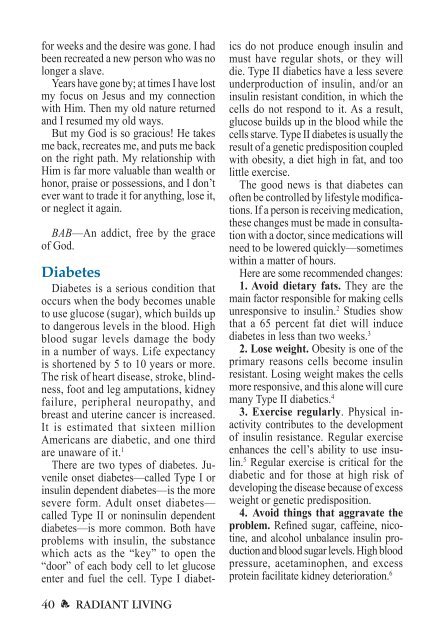Radiant Living
Create successful ePaper yourself
Turn your PDF publications into a flip-book with our unique Google optimized e-Paper software.
for weeks and the desire was gone. I had<br />
been recreated a new person who was no<br />
longer a slave.<br />
Years have gone by; at times I have lost<br />
my focus on Jesus and my connection<br />
with Him. Then my old nature returned<br />
and I resumed my old ways.<br />
But my God is so gracious! He takes<br />
me back, recreates me, and puts me back<br />
on the right path. My relationship with<br />
Him is far more valuable than wealth or<br />
honor, praise or possessions, and I don’t<br />
ever want to trade it for anything, lose it,<br />
or neglect it again.<br />
BAB—An addict, free by the grace<br />
of God.<br />
Diabetes<br />
Diabetes is a serious condition that<br />
occurs when the body becomes unable<br />
to use glucose (sugar), which builds up<br />
to dangerous levels in the blood. High<br />
blood sugar levels damage the body<br />
in a number of ways. Life expectancy<br />
is shortened by 5 to 10 years or more.<br />
The risk of heart disease, stroke, blindness,<br />
foot and leg amputations, kidney<br />
failure, peripheral neuropathy, and<br />
breast and uterine cancer is increased.<br />
It is estimated that sixteen million<br />
Americans are diabetic, and one third<br />
are unaware of it. 1<br />
There are two types of diabetes. Juvenile<br />
onset diabetes—called Type I or<br />
insulin dependent diabetes—is the more<br />
severe form. Adult onset diabetes—<br />
called Type II or noninsulin dependent<br />
diabetes—is more common. Both have<br />
problems with insulin, the substance<br />
which acts as the “key” to open the<br />
“door” of each body cell to let glucose<br />
enter and fuel the cell. Type I diabetics<br />
do not produce enough insulin and<br />
must have regular shots, or they will<br />
die. Type II diabetics have a less severe<br />
underproduction of insulin, and/or an<br />
insulin resistant condition, in which the<br />
cells do not respond to it. As a result,<br />
glucose builds up in the blood while the<br />
cells starve. Type II diabetes is usually the<br />
result of a genetic predisposition coupled<br />
with obesity, a diet high in fat, and too<br />
little exercise.<br />
The good news is that diabetes can<br />
often be controlled by lifestyle modifications.<br />
If a person is receiving medication,<br />
these changes must be made in consultation<br />
with a doctor, since medications will<br />
need to be lowered quickly—sometimes<br />
within a matter of hours.<br />
Here are some recommended changes:<br />
1. Avoid dietary fats. They are the<br />
main factor responsible for making cells<br />
unresponsive to insulin. 2 Studies show<br />
that a 65 percent fat diet will induce<br />
diabetes in less than two weeks. 3<br />
2. Lose weight. Obesity is one of the<br />
primary reasons cells become insulin<br />
resistant. Losing weight makes the cells<br />
more responsive, and this alone will cure<br />
many Type II diabetics. 4<br />
3. Exercise regularly. Physical inactivity<br />
contributes to the development<br />
of insulin resistance. Regular exercise<br />
enhances the cell’s ability to use insulin.<br />
5 Regular exercise is critical for the<br />
diabetic and for those at high risk of<br />
developing the disease because of excess<br />
weight or genetic predisposition.<br />
4. Avoid things that aggravate the<br />
problem. Refined sugar, caffeine, nicotine,<br />
and alcohol unbalance insulin production<br />
and blood sugar levels. High blood<br />
pressure, acetaminophen, and excess<br />
protein facilitate kidney deterioration. 6<br />
40 s RADIANT LIVING
















